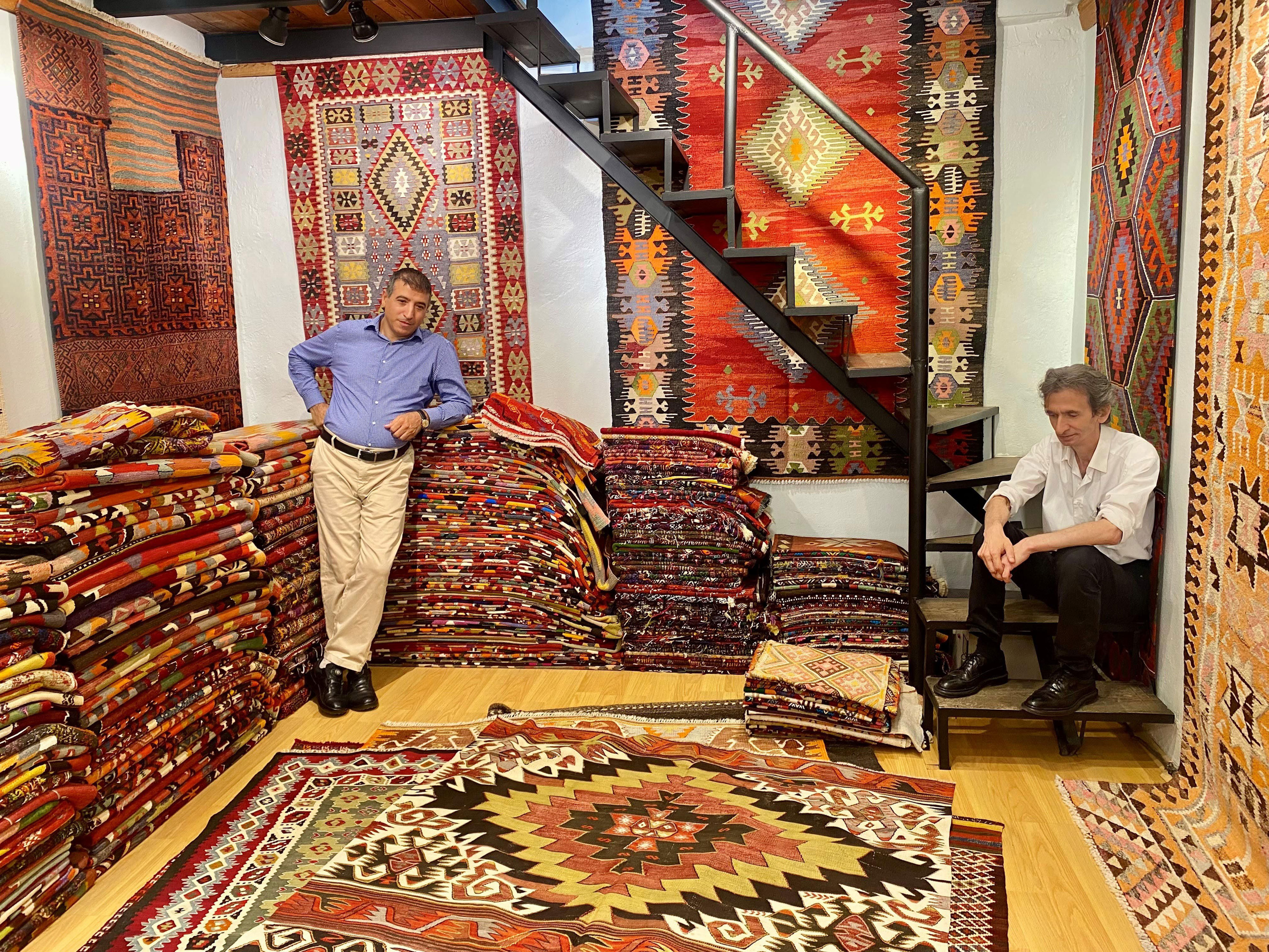
POSTCARD FROM ISTANBUL: TURKEY'S CARPET TRADERS WEATHER THE ECONOMIC STORM
Hikmet Sirlak cannot think of doing anything else in life other than selling carpets.
“I have been living in this area since 1973 and I had to go through this street in the bazaar to go to school. You can say I was born into it,” said Hikmet, a wiry man of 60.
He found himself drawn into the carpet trade and now sells from a shop tucked away under the turquoise painted ceilings of Istanbul’s Grand Bazaar.
“The carpet business has a magnetic field,” said Hikmet, speaking from the small store, which is named after the trader who founded it almost 60 years ago, Recep Karaduman.
Hikmet sources carpets and kilims – flatweave rugs – from small traders around Turkey, and mostly sells wool pieces from the 1960s and 1970s from the country’s south-west.
“They are not necessarily beautiful kilims,” he said. “I always say beauty is perfect, so it is boring.”
But they are beautiful. A rare mustard yellow runner with burgundy star patterns from Sivas in central Turkey tops a chunky pile of rugs. A burgundy red kilim has been christened the Frida Khalo as its orange, green and white geometric patterns (sort of) resemble the famous artist’s eyebrows.
We do not necessarily sell beautiful kilims. I always say beauty is perfect, so it is boring.
Hikmet Sirlak, carpet trader
Hand-knotted carpets and kilims have a long history in the land that is now Turkey, and across the Middle East and central Asia.
A new exhibition at Istanbul’s Turkish and Islamic Arts Museum exhibits a majestic indigo blue and ruby red carpet that is at least 700 years old. Pieces in the exhibition, brought in from foundations and mosques across Turkey, feature vertical Kufic script and triangles representing arrowheads.
Other Ottoman-era pieces in ochre, red and turquoise were part of a manufacturing industry spurred on by the empire’s growing prosperity.
A separate exhibition in the same museum displays exquisite silk sofrahs (tablecloths), prayer mats and mahfazas (purses) from the silk factories of Ottoman-era Syria and Lebanon. Their forms are more delicate, their colours brighter than the Anatolian designs, and show the rich array of textiles produced across the former empire.
Carpet-weaving in Turkey has traditionally been considered women’s work. The carpets had an element of self-expression, with unplanned designs reflecting whatever the weaver wished. Carpets would also be woven by women after marriage, giving them the freedom to choose the interior design of their new homes.
“In the villages where the weaving took place, they had no radio, no paper, no pens,” Hikmet said. “So even if a woman wanted to copy her neighbour’s kilim, she would have to go and look at it.”
The manufacture of carpets in Turkey today is in steep decline, sellers said. Rife competition comes from machine-made imports: their gaudy colours and shiny piles shout from elsewhere in the Grand Bazaar, a centuries-old trading hub that has increasingly become a tourist trap.
The nomads who used to weave some carpets have settled in villages and towns, and the time-consuming weaving process does not bring in a solid income.
But Hikmet is sanguine about the challenges.
“A carpet seller cannot complain about the ups and downs,” he said with a shrug. “We are always affected by political conditions globally. A carpet dealer who complains about that doesn't know about carpets.”
He believes that there is growing demand among people who appreciate the effort and time that goes into producing each carpet – one piece often takes months to make. Before sale, he has antique carpets washed and repaired: one 19th century piece in deep brown and cream looks as good as new.
Istanbul's carpet market also brings in traders from further afield, including Afghanistan, where it provides a vital means of income.
Abdul Cebbar Seyidoglu, 65, was born into a Turkman family in northern Afghanistan. Like many other Afghan Turkmen, he saw better opportunities in Turkey, where he later gained nationality.
His son Shukru, 27, is now leading the family business in Istanbul.
“My grandfathers chose to go into the carpet trade – I am the fourth generation in this business,” Shukru said from his shop, Saruki Carpets, down a side street in Sultanahmet district.
Eighty per cent of the carpets sold at Saruki are made in Afghanistan, before being trucked across land to Istanbul.
“People don't have a lot of work – the Turkman, Uzbek and the other populations of Afghanistan as well,” Shukru said. “So that's why they are making carpets – we order them, bring them here, and export them all over the world.”
Most of his customers are from the US, while other buyers are from Europe and Canada.
His favourite piece is a large red antique Afghan rug carrying an “elephant’s foot” motif, designed by his father. He is also selling a large cobalt blue rug from Afghanistan’s Baloch community; a delicate two-minaret mosque is hidden in the pattern.
Like Hikmet, Shukru also sees the challenges facing carpet traders in Turkey. The country is facing a years-long economic crisis and inflation of over 70 per cent, reducing consumers’ purchasing power. Exchange rate fluctuations have also complicated imports and exports.
But he remains determined to continue his family’s business, and not allow mass-produced items to eliminate traditional textiles.
“Machine-made items do not have any history,” Shukru said. “They have designs – but they are copied from the handmade carpets.”
Turkish Carpets: The Art Knotted with Love and Syrian and Lebanese Textiles of the Ottoman Era are on at the Turkish and Islamic Arts Museum in Istanbul until August 23.
2024-07-26T18:13:55Z dg43tfdfdgfd